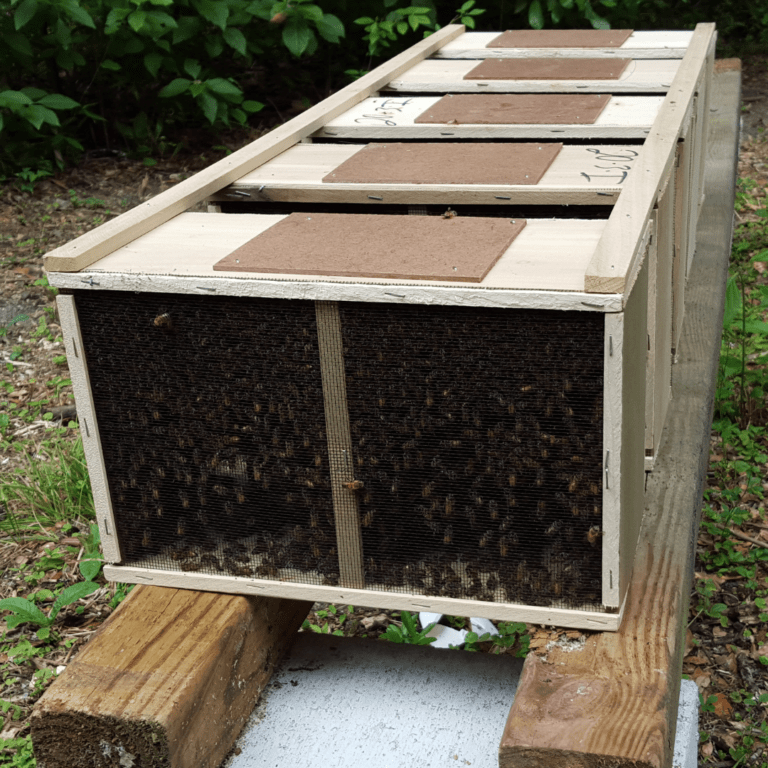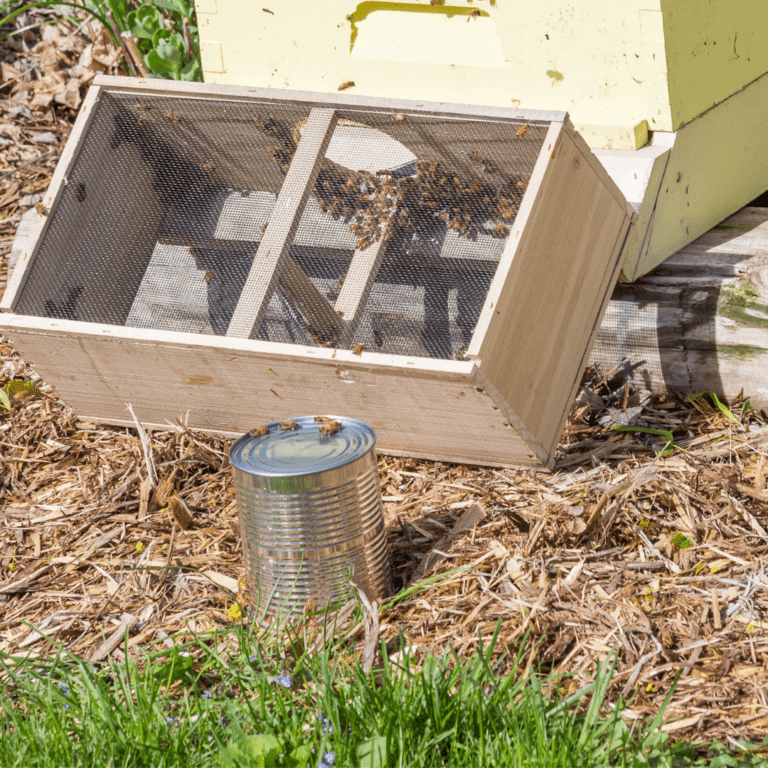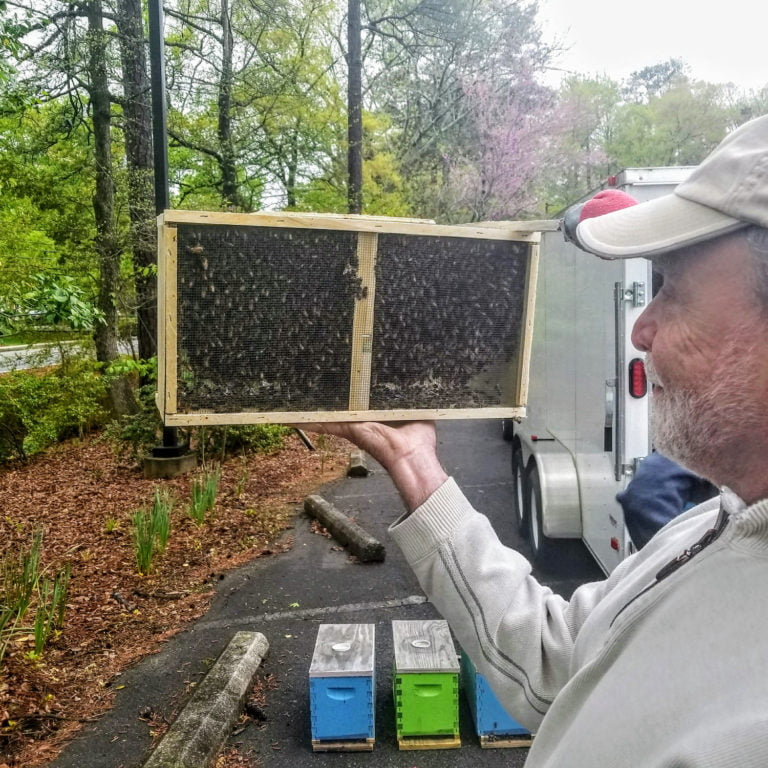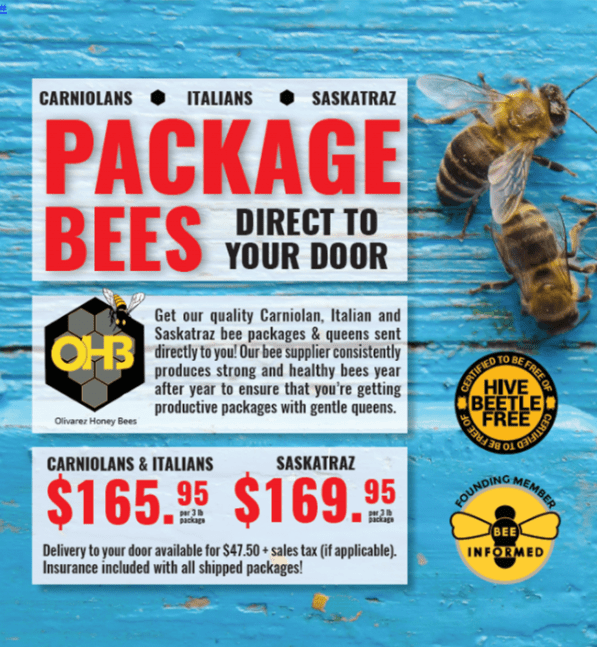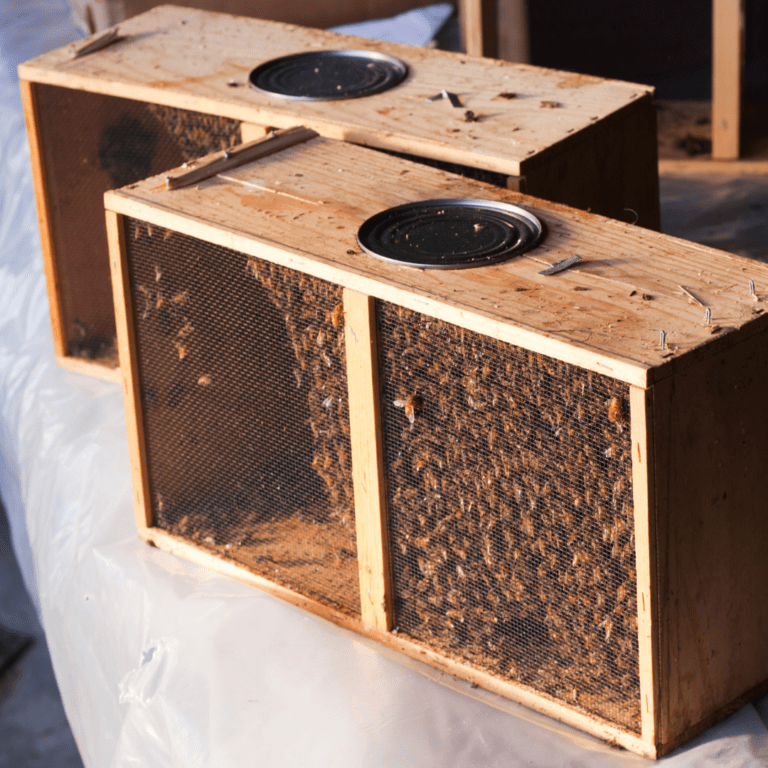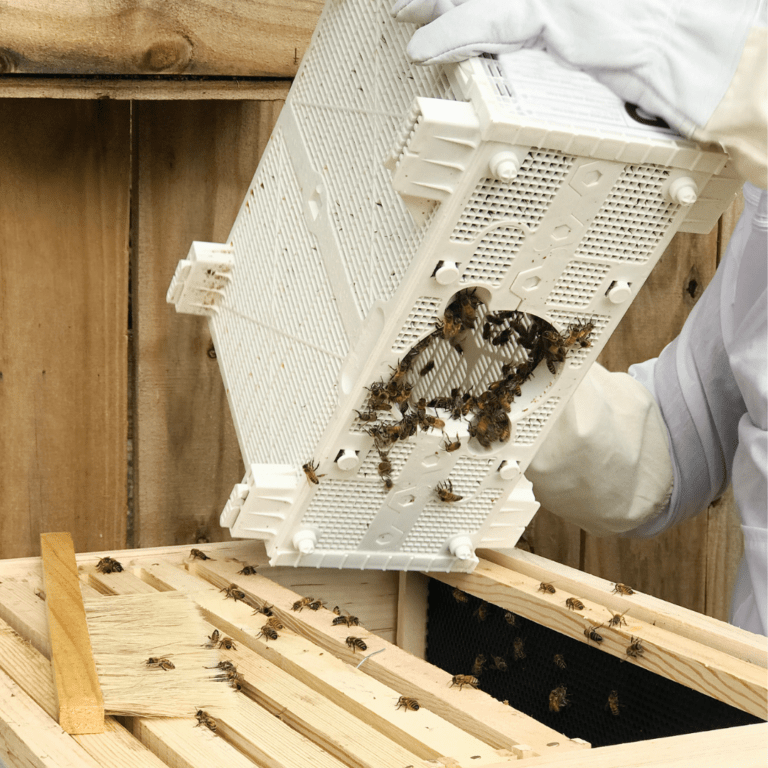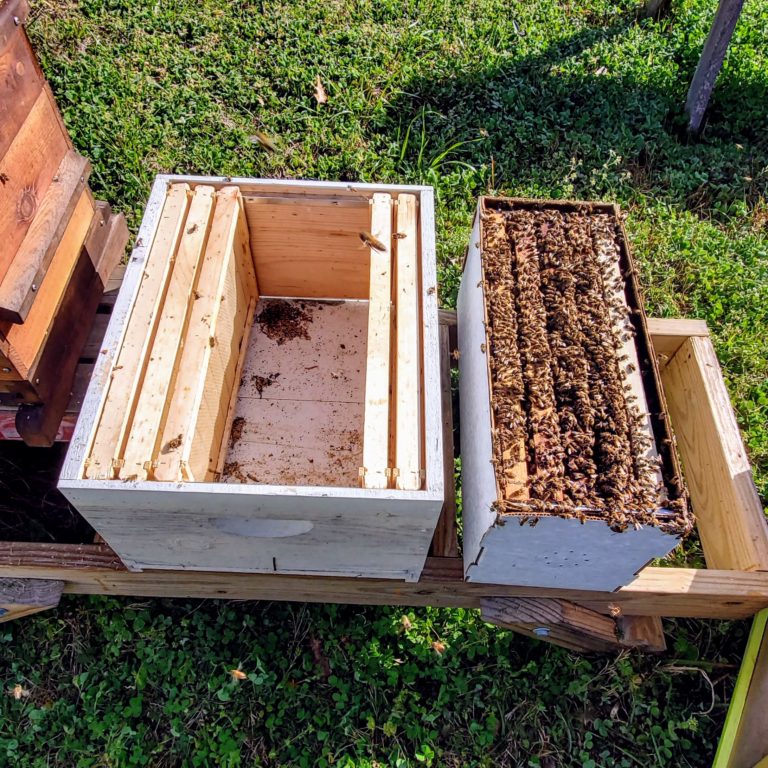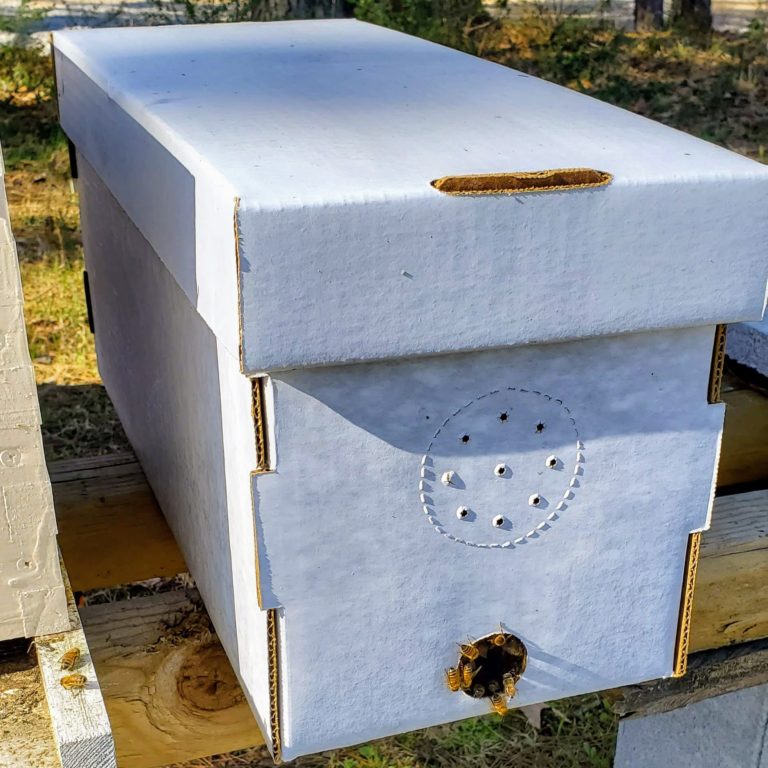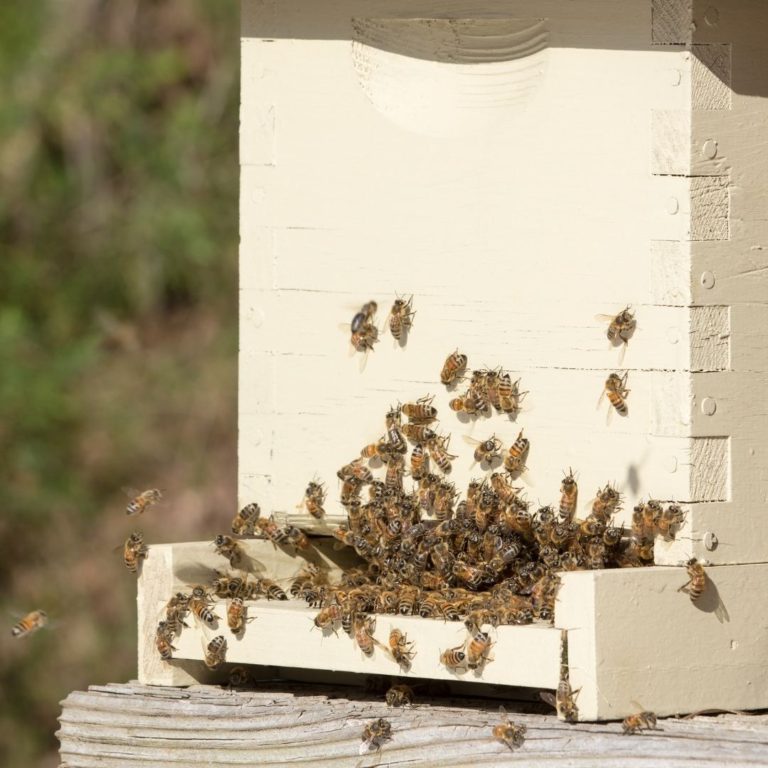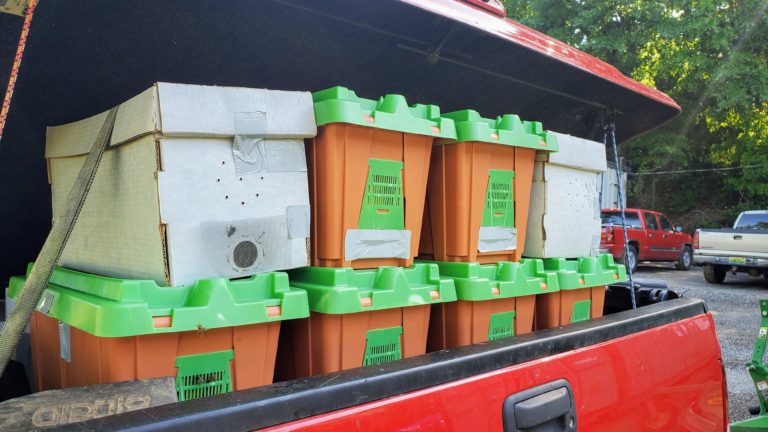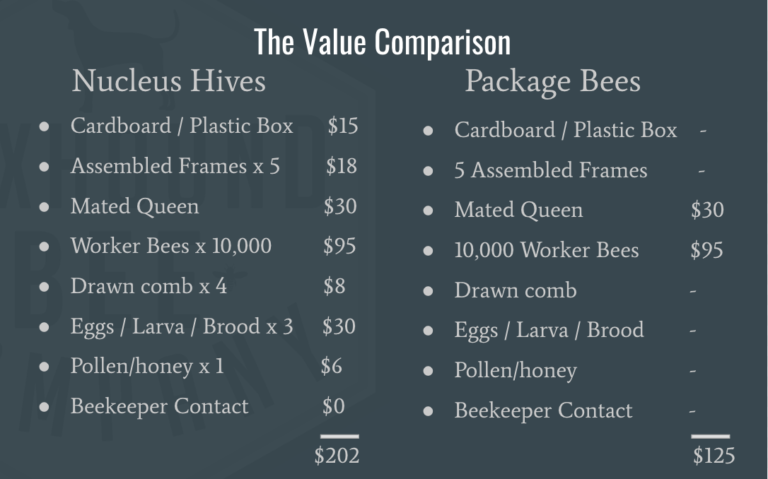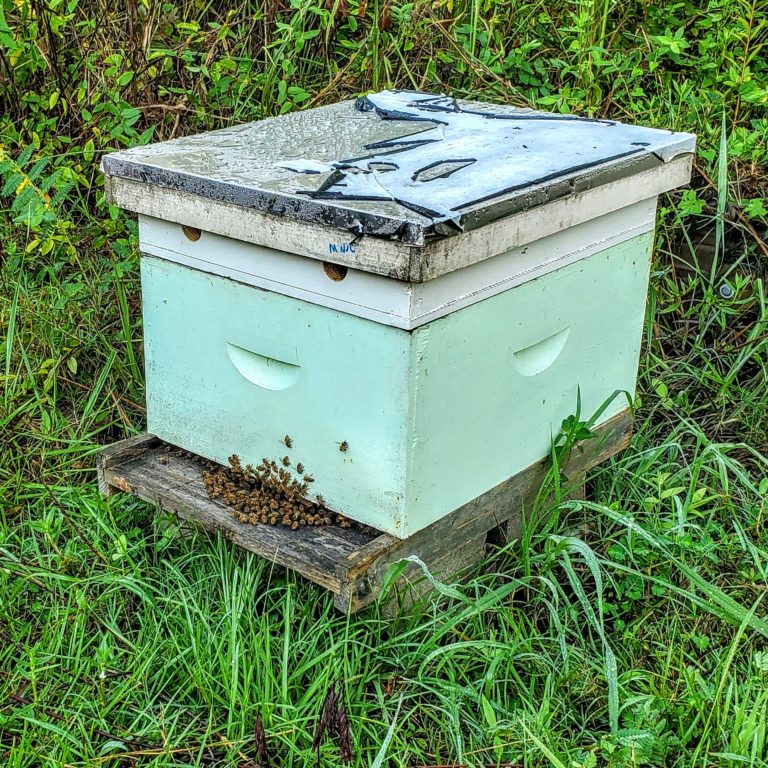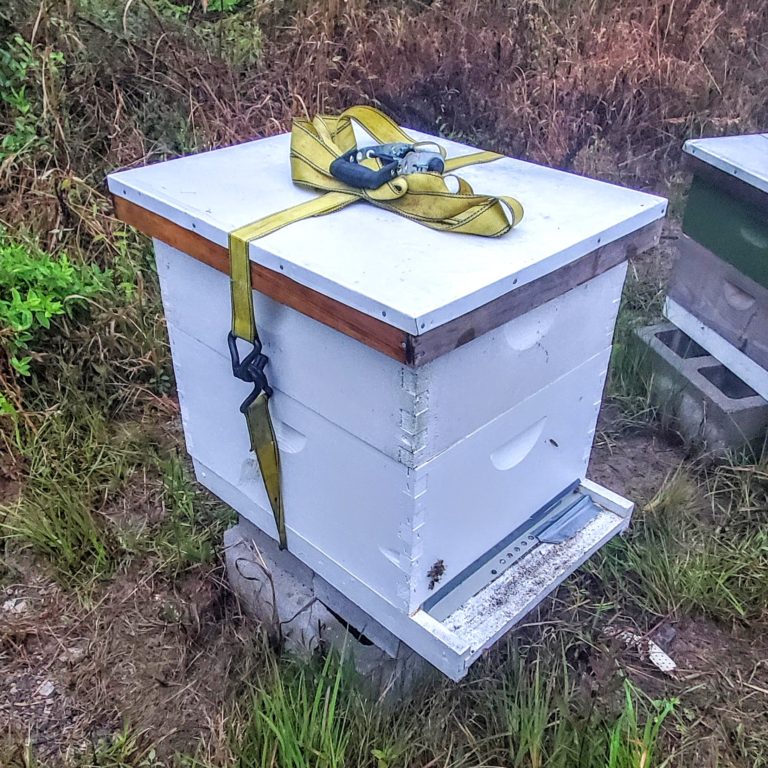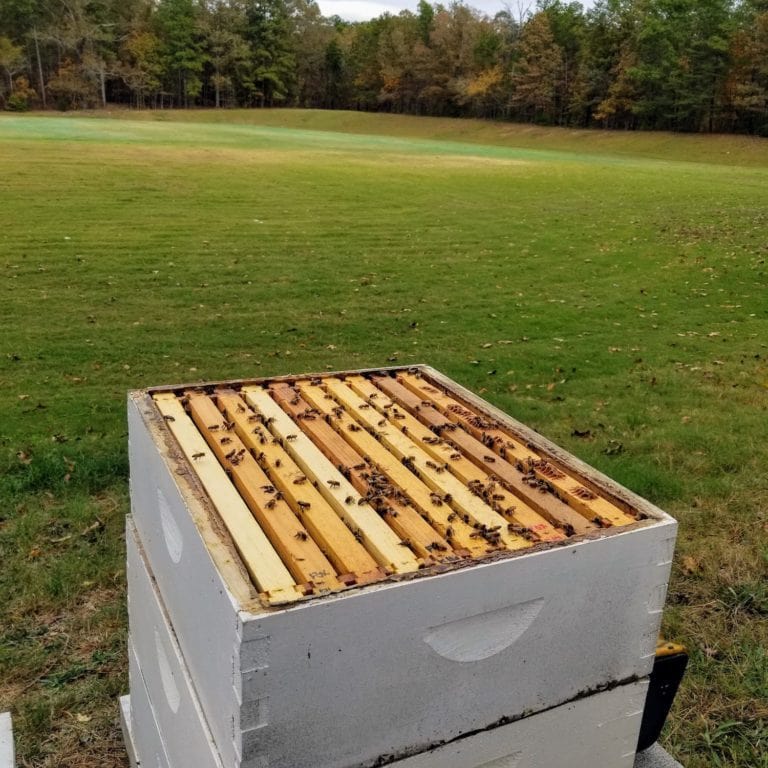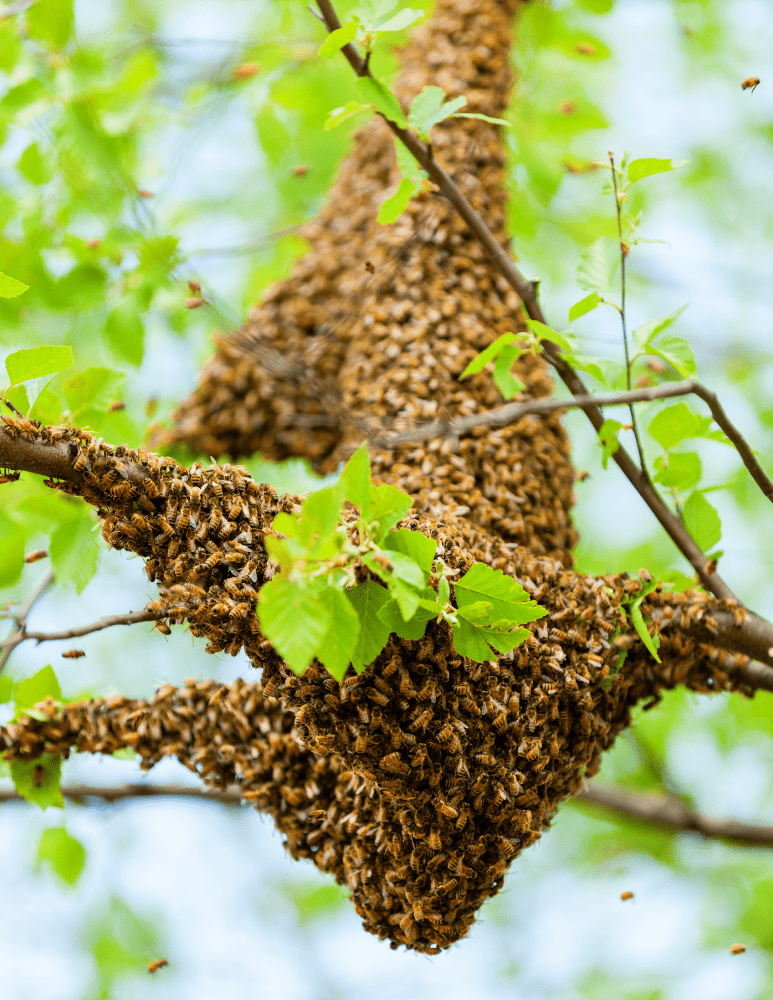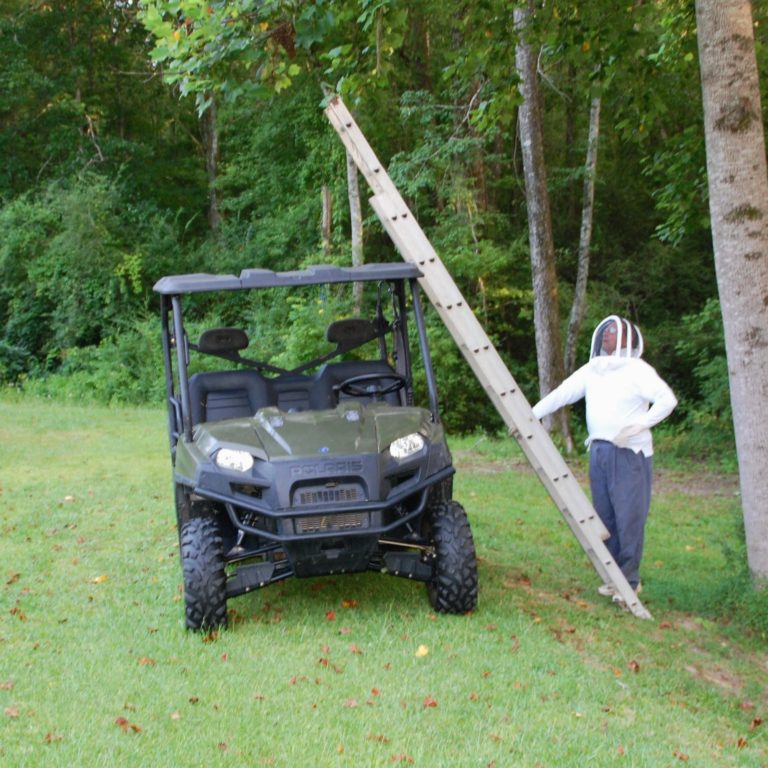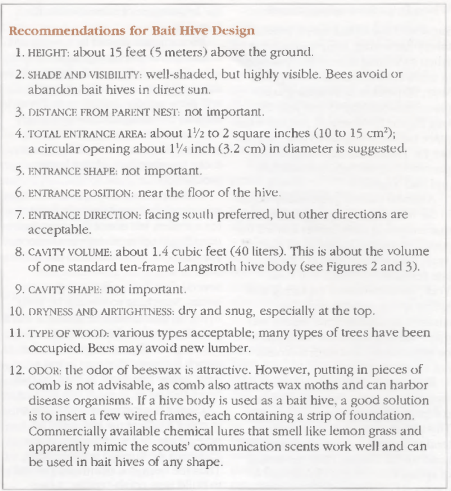From our experience of getting new beekeepers started, no part of the beginning is harder than finding bees. Sometimes beginner beekeepers strike gold and get lucky right away.
Other times, beekeepers need to call around trying to find honey bees. The good news is that the earlier you start looking for bees, the easier it will be to find a beekeeper to buy them from.
If you start looking for bees in November, you will have an easier time finding them than waiting until March. If you know you want to start beekeeping, then it pays off to lock down a source for bees in the fall. Don’t wait, or you may have to settle for starting later in the year or getting less desirable bees. More below.
Starting a colony requires more than just the queen bee. A colony of bees is full of worker bees responsible for different roles inside and outside the hive.
It takes a minimum amount of worker bees to sustain the colony and support the single queen bee. So when shopping for bees, you’ll see colonies described in numbers, frames, and pounds of bees. It can be a little confusing but know you can’t start with just a single queen bee or wild bees collected from flowers.
Table of Contents
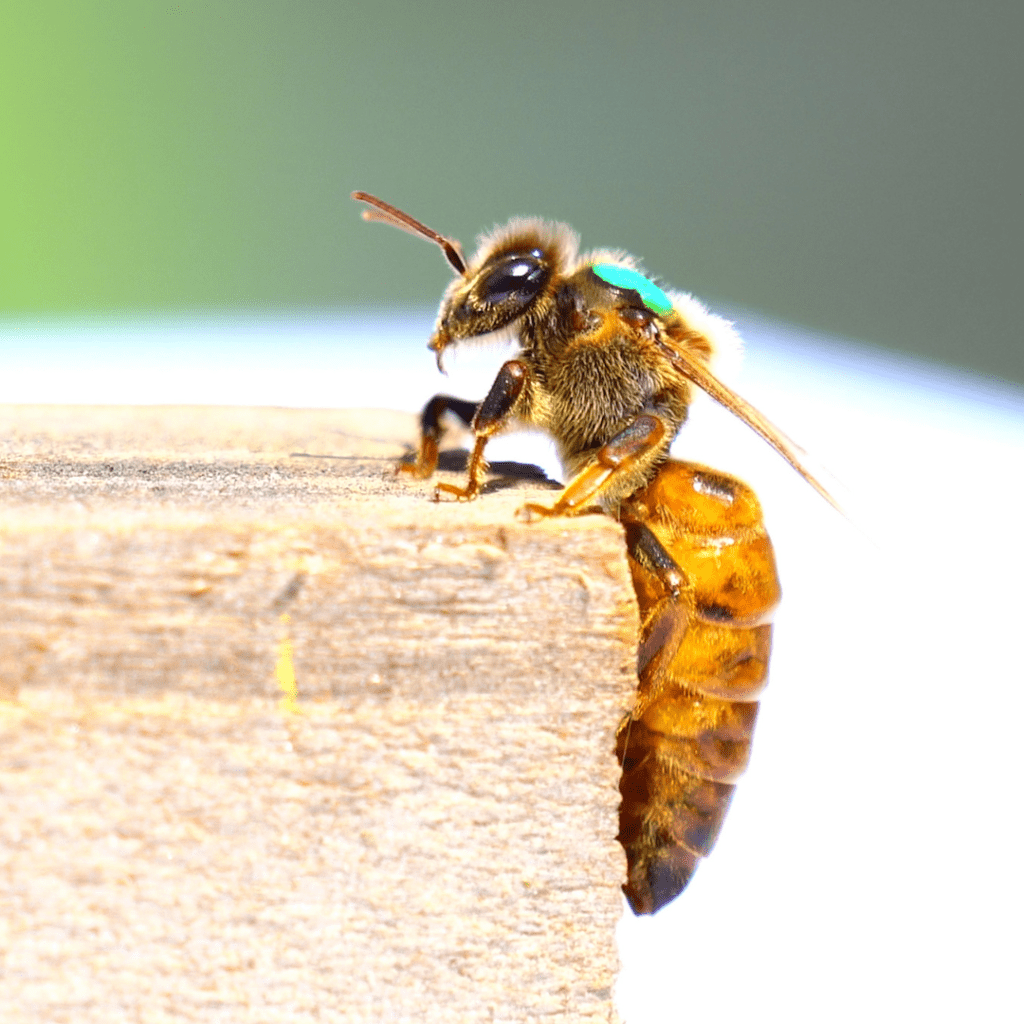


Five Ways To Get Your Bees
For the sake of being thorough, this is a guide outlining the 5 different ways you can start your own colony. In our experience, 95% of beginner beekeepers start their colonies with the first two options. There are good reasons for this, mainly because both are easier to source and easier to start with.
After maintaining your own colonies for a couple of years, there are a few other options available to you, but you have to already have bees to use these options.
- Package Bees
- Nucleus Hives
- Full-Size Hives
- Swarms
- Cutouts

Package Bees
Package bees are the most common way to start a hive as they are easy to produce and easy to distribute. Packages are to the bee industry as the Model T was to Ford. Both are simple to produce, affordable and can be transported easily. An interesting thing about packages is that they can be shipped across state lines without violating any state laws. Some types of hives, however, can’t be moved from one state to another.
A package of bees describes a small box about the size of a shoebox that is full of worker bees and a single queen. The amount of worker bees is about 10,000 bees, which is often described as 3lbs. When a package of bees is advertised, it’s typically described in lbs. The lbs represent the weight of the worker bees, not the weight of the whole container and bees.
The ten thousand bees in a package are easy to produce because a percentage of worker bees is taken from multiple hives and dumped into the package container using a funnel. The worker bees in a package are typically from 2 or 3 different hives.
We compare package bees and nucleus hives in depth here.
What's in a package of bees?
- A wired or plastic screened box
- A can of sugar syrup to feed bees during transport
- A lid to keep the sugar can and bees inside the hive during transport
- 2 – 3lbs of female worker bees (6,000-10,000 bees)
- One queen cage containing
- 1 mated queen
- 1-5 worker bees to feed queen during transport
- Candy / Fondant plug to help with releasing the queen
How Much do Package Bees Cost?
Package bees are the most affordable option for starting your own beehive, which is why they are so popular. Beekeeping clubs will often offer discounted prices on packages for their members and provide a convenient place to buy your bees.
Prices through a club can range between $100-130 per package. Most beekeepers start with two hives, so you would need two packages for them.
We have seen packages go for as much as $170 before, which is a very high price for package bees. These prices are for beekeepers picking packages up themselves and not having them shipped. Package bees can actually be shipped to you (more below) and shipping will add another $40+ to the package price.
It’s standard procedure to order your bees a month or more before the bees are actually delivered. It’s wise to preorder in December/January and not wait until February, or certainly not March.
Most packages are delivered in March and April and will easily sell out in most places. If you order late, you could find a beekeeper selling a nucleus hive or possibly get a package in May or June.
Pros and Cons of package bees
The vast majority of packages are made by a relatively small group of beekeeping operations. It is not common for a local beekeeper to make their own packages as it takes a lot of hives and an efficient operation to make the affordably. The majority of beekeepers start their hives with packages because they are readily available, and these companies will typically distribute their packages through beekeeping clubs or local beekeeping stores.
Unfortunately, there are a few negatives with starting a hive with package bees. The greatest of these is the failure rate of package bees during their first year. I suspected this and spoke with a package producer in person about it.
"In the hands of a beginner beekeeper, what percentage of package bees survive their first year?"
The answer was about 60%. This means 4 out of 10 packages die during their first year… that’s not good.
Now, this isn’t indicative of all packages, and there are certainly a few things beekeepers can do to minimize the risk of the bees failing. Most of the reasons packages die during their first year are completely out of control of the beekeeper, but there are a few things a beginner beekeeper can do to help their bees be successful.
The takeaway from this is to know that, while package bees can be easy to get, they have more room for error than other options available to beginners.
Nucleus Hives
For the beginner beekeeper starting their first two hives, two nucleus hives are typically the best option. They are easy to install into your own equipment, have a high success rate and you can typically find them locally. They might be tougher to find because a Google search doesn’t always turn up a source for nucleus hives. One of the best aspects of buying a nucleus hive is that it is an incredibly good value for your money. Gotta love a good deal.
Nucleus hives are also called a Nuc (pronounced: newk (rhymes with duke) or sometimes nook (as in rhymes with book).
Nucleus: the central and most important part of an object, movement, or group, forming the basis for its activity and growth.
A nucleus hive is everything that is in a full-size hive but on a smaller scale and easy to transport. When buying a nucleus hive, you are getting the core of a full-size hive, all the important parts, and resources to grow.
In fact, when beekeepers make nucleus hives to sell, they take about 1/3rd of an existing hive and a new queen, and these are what are sold as a nuc. Nucleus hives are about 3-4 weeks ahead of a package of bees, giving your new colony and yourself a good start on the year.
What's in a nucleus hive?
- A corrugated, wooden, or plastic box
- 5 assembled frames with foundation
- 3 frames with unhatched, developing bees (about 15,000 bees)
- 1 frame with a mixture of honey and pollen
- 1 frame for bees to start using
- About 10,000 (3lbs) adult worker bees
- A mated (uncaged) queen already laying eggs
How Much do Nucleus Hives Cost?
Nucleus hive prices can vary greatly as they are set by the individual beekeeper selling them. That said, $125 for a nucleus hive is a good price and we have seen them for around $250. Again, this will vary on the source and the part of the country. Nucleus hives are still a good value at $200, especially earlier in the year.
We priced out all the different elements of what’s included in the nuc, from the box to how much a frame of fully developed honeycomb is worth. It adds up to roughly $200 and this is a conservative number.
The value of a nucleus hive does decrease as the year goes on. A nuc received in March or April is more valuable than the one you get in July or August. The closer to winter you start a hive, the harder it is for bees to survive the winter, so an August Nuc isn’t as valuable.
You can order nucleus hives from us for pickup in Birmingham, Alabama from our store. Click here for more info.
Nucleus Hives as a good value
I mentioned earlier that nucleus hives are good value. Their value comes is due to several factors. For example, I said the nuc is about 3-4 weeks ahead of a package of bees. During these 3-4 weeks, a nucleus hive can expand into a larger box, building more of their comb and storing honey in preparation for winter. Typically, when a new colony is being established, both packages and nucs, it is started in the spring during the period when everything is blooming. A nuc will better capitalize on all the nectar in those flowers than a package of bees can. This means you won’t have to feed the nucleus hives as much sugar water to prepare them for winter.
Another excellent value a nuc provides is that you typically get to keep the box the bees came in. This box can be a lifesaver later, as it would be a great way to start another hive later or to catch a swarm of bees with.
Yet another advantage nucs have over packages is that the queen inside the nucleus hive is already laying eggs and is the mother of the bees in the hive. In a package, the queen is not related to the worker bees in the package and they are very likely to replace her as soon as they get the opportunity.
Watch our video on how to install a nucleus hive

Packages or Nucleus Hives, Which is Better?
Keeping bees healthy is a tough job, and it takes decades to get good at. When starting to keep bees, the learning curve is steep for
A Note On The Queens In Nucs And Packages
You don’t have to look for bees long before you notice different types of queens being advertised, along with claims about those queens. All of the queens advertised are the same species of honeybees we all think of. But you could think of them as belonging to different races or genetic lines.
Bee sellers have preferences for certain types of queens with various desirable traits. When we teach classes, we compare the different queens to different types of dogs. Generally, an Italian queen will breed good honey-producing bees that will be less defensive towards their beekeeper. Typically, a golden retriever will be a good family dog. But these are just generalizations, however, and not always the case.
This is to say there are differences between the queens, but for a beginner beekeeper, the differences are almost a moot point and do not always determine success or failure during their first year.
If given the choice to choose one type of queen over the other, then choose what looks good to you. Nevertheless, it shouldn’t keep you from starting a hive if you don’t get the queen you want.
Full-Sized Bee Hives
Buying a full-sized hive from a beekeeper is not very common and can lead to difficulties for a beginner beekeeper. Think about buying a dog for a child. When the child is small, it’s helpful to have a puppy because it is small also and can grow with the child. Compare this scenario to buying an 8-year-old german Sheppard for the same kid. Likewise, a full-sized hive may be more than a beginner beekeeper can handle and could also come with unforeseen issues.
What is included in a full-sized hive can vary but will always contain at least 8 frames or 10 frames, a box to hold them, a bottom board, and a cover. Sometimes, beekeepers will sell two boxes with the hive. Moving full-sized hives can be difficult for one person because they are heavy and cumbersome. This alone is what makes nucleus hives popular and full-sized hives less popular.
Buying a full-sized hive from a beekeeper is not very common and can lead to some difficulties for a beginner beekeeper. Think about buying a dog for a child. When the child is small, it’s helpful to have a puppy because it is small also and can grow with the child. Compare this scenario to buying an 8-year old german Sheppard for the same kid. Likewise, a full-sized-hive may be more than a beginner beekeeper can handle and could also come with unforeseen issues.
What is included in a full-sized hive can vary but will always contain at least 8 or 10 frames, a box to hold them, a bottom board, and a cover. Sometimes, beekeepers will sell two boxes with the hive. Moving full-sized hives can be difficult for one person because they are heavy and cumbersome. This alone is what makes nucleus hives popular and full-sized hives less popular.
What's in a full-sized hive?
- A bottom board
- A telescoping cover or migratory cover
- An inner cover if using a telescoping cover
- 1 or 2 assembled (8 or 10 frame) Langstroth boxes
- 8 – 10 assembled frames per box
- 6 – 7 frames with developing bees
- 1 – 2 frames of honey and pollen
- 1 – 2 frames for bees to build on
- A mated, uncaged and laying queen
- About 20,000 female worker bees or more
How Much do Full-Sized Hives Cost?
Full-sized hives can vary in price depending on the motivation of the seller. Using our nucleus hive as a baseline for the cost of a full-sized hive, they would typically cost around $250-300.
An excellent price for a full 10-frame hive with one box would be $225, a little less for an 8-frame hive and more for a hive with multiple boxes.
If buying a full-sized hive, it is smart to ask exactly what equipment is included and how old it is. If the hive is including multiple boxes, it will be significantly harder to move with one person, so keep that in mind.
If honey production during your first year is essential, then a full sized hive will be your best bet.
Swarms of Bees
To experienced beekeepers, a swarm of bees hanging on a tree looks like a hundred-dollar bill. Catching swarms is a very popular activity for beekeepers during the spring and summer, and it’s not uncommon for beekeepers to keep swarm catching supplies in their vehicle for when the opportunity arises. Beekeepers will typically receive calls from the public about removing a swarm of bees and will almost always remove them for free. It’s a win-win for everyone.
What is a Swarm of Bees?
A swarm of bees may just be some bees flying around in public, but it is actually a specific event. Simply put, a swarm is a group of honeybees and their queen who’ve split from their previous colony to start a new colony in a new location. This is how honeybees reproduce, turning one colony into two.
To read more about what a swarm of bees is, click here.
What's in a swarm?
- 3,000-30,000 female worker bees
- 1 mated, laying queen (usually)
How Much do Swarms Cost?
We already said that a swarm of bees is like a $100 bill hanging on a tree for you. They are essentially free, but they do cost to capture them. One thing to consider is your time to go out and get them. It is very common for a swarm of bees to land in a tree and move to a new location in only a matter of hours. A swarm will only be in place for a couple of days at most, so there is always a chance it could leave before you show up.
While a swarm is free, there is a lot you may be giving up in order to get one. They are also better suited for expanding a beekeepers group of hives than establishing the first one.
And sometimes everything sounds great and you realize once you arrive, that forgot to ask how high up in the tree it is. Fortunately, there are helpers that have a ladder handy to help!

What Happens To Bees In Freezing Weather?
Winter is pretty hard on animals, and while we may not think about it much, honeybees and other insects have to survive the cold each year.

Why Use Cypress For Beehives? Pine, cedar, poplar, and cypress are common woods used for bee hives. All woods have positives and negatives, especially when
The reasons swarms aren't great for Beginner Beekeepers
A big swarm of 10,000+ bees is one of the best ways for a beekeeper to start a new colony with little effort. Starting a new colony is what swarms are made for, so it’s a rare beekeeper who will pass one up. So why isn’t this good for a beginner? Well, the swarm is great, but getting it isn’t.
Catching a swarm is not a reliable way to start your first colony. It would be disappointing to take classes, buy equipment, get set up and go all spring and summer and never get the chance to catch a swarm.
Unless you depend on the sheer luck of stumbling into a swarm, your only hope of catching a swarm is getting called to remove one from the public. FYI, most bee clubs have a list on their website of beekeepers who will do this, so add your name to the list if you want to get swarm calls.
The public doesn’t always give you the right information about removing swarms. Countless beekeepers have arrived to remove a swarm only to find the following: it’s a wasp nest, bumblebees foraging on flowers, a full-sized colony in an attic, another beekeeper already getting the swarm, carpenter bees, a swarm that has already left, ground-dwelling solitary bees, a swarm on a limb 60′ up a tree, bees IN a trunk 60′ up a tree, or a swarm that has already been sprayed with wasp spray… These are all very real calls we have received on “swarms.”
The person who called us about removing the bees sprayed with wasp spray was a doozy, and I shouldn’t go into it. A beginner beekeeper wouldn’t know the questions to ask to vet these calls to see which ones are actually feasible and which ones are asking you to rescue bees they already killed.
Luring A Swarm Of Bees In
I’ve talked a lot about going out and catching swarms, but you can actually bring swarms into you. It is still a game of luck, but there are a few tricks you can do to bring the swarms into you. If you are set on getting bees for free, this is your best bet for it.
This is the trap designed specifically for catching swarms.
There are some well-established standards for what a swarm likes and doesn’t like. The more you set up space for a swarm to move into that is what they like, the better chance you have of catching one.
In a nutshell, you set up an empty container that looks attractive to a swarm of bees, and with any luck, a swarm will move into it on their own. Then you would remove the container and place the bees in a new container in a place that is more appropriate for them. There are some commercial products that make the process much easier such as Swarm Commander spray that swarms like the smell of. And using a 10 frame deep box with a top and bottom as it is the ideal net cavity bees prefer. Below is the golden standard for setting up a swarm hive, established by Tom Seeley in “Honeybee Democracy“.
- 15′ from the ground
- Shaded, but with high visibility
- Entrance size – 1 1/2-2 square inches (about a 1 1/2-inch hole) near the floor of the hive
- Volume – 40L – Roughly that of a 10-frame deep box
- Southern facing entrance
Bees prefer to have the cavity of the swarm trap completely empty and not filled with frames with foundation. Foundation-less frames would be ideal as it would meet the needs of the bees and still be easy to transport to a new hive.
Cut Outs
This is an option and really not a great one for beginners. But we wanted to be thorough in the options available to you. A cut out is the beekeeping industry term for removing a colony of bees that has been living in a space for at least a week. They can be very complicated and require specialized equipment like a bee vacuum to remove them.
This colony of bees has set up residence and decided that where they are will be their new home. The colony could have been there only a week or decades.
These are not a great option for beginners as it requires specialized equipment to successfully remove the colony from their cavity without causing too much damage to their comb or accidentally killing the queen.
The colony’s location is usually difficult to get to, like under the floors of a house, in a tree, or inside the 3rd story wall of a building. Nearly every cut-out requires some construction to get to the bees, adding another difficulty layer. These pictures were taken with a thermal camera attachment for a phone. If you are interested, read our blog on them here.

Master Guide – Beekeeping For Beginners
Table of Contents Starting a beehive and taking care of it is a lot of fun. From unpacking your new beekeeping suit to pouring (yes,

Master Guide – Is Beekeeping Right For Me?
Is beekeeping right for me?: Part 2 of 5 in our ultimate guide to getting started in beekeeping. Find out if you are the type

Master Guide – What Beekeeping Equipment Do I Need?
Figuring out beekeeping equipment is the most intimidating part of getting started in beekeeping. There are a lot of options, designs, and equipment configurations to

Master Guide – Where Do I Get Bees?
From our experience of getting new beekeepers started, no part of the beginning is harder than finding bees. Sometimes beginner beekeepers strike gold and get
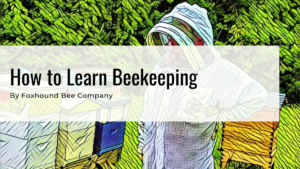
Master Guide – How To Learn Beekeeping?
Learning to become a beekeeper is a rewarding and challenging experience. There are a lot of ways to learn how to keep bees, and we
Finding Bees Locally
We are advocates of supporting your local beekeeping community, and the best and easiest way you can do this is to buy bees from beekeepers who actually keep bees. Once you get into beekeeping, you will realize more people have bees than you thought, and the beekeeping community is very thoughtful and helpful. I’m talking about the local community here, not the Facebook community, which can do more harm than good.
If you would like to buy nucleus hives from us, we would appreciate it. More details here.
Local Packages
If buying package bees locally, they are typically being resold and are originally purchased from a large package supplier in Georgia, South Carolina, Florida or California. These states produce a lot of packages and ship their packages all over the country. These packages are typically picked up in a well-ventilated trailer (to keep them cool) and delivered the following day to individual beekeepers who have pre-ordered them.
Know that even if package bees are purchased from a local beekeeper or club, they shouldn't be considered "local bees."
It is not uncommon for a beekeeping club in the northeast to organize a pickup in Georgia for several hundred packages of bees. The bees are often picked up and delivered in less than 24 hours to minimize the harm and stress to the bees.
Finding Package Bees For sale
Finding a source for package bees isn’t too difficult, and a simple search for your local beekeeping club may reveal a source. To find them, google “(your county/city/part of your state) beekeeping club,” and it should turn up some information. If you have a local beekeeping supply company, they may have some information on their website as well. Individual beekeepers typically do not sell packages, so they would not be a great source.
Local Nucleus Hives
Nucleus hives are typically sold directly by the beekeeper who made them, which is great on several levels. The vast majority of nuc sellers are backyard beekeepers who are only selling a few or a couple of dozen nucs. Meaning, they are fairly small-scale beekeepers and doing it to make a little extra money and also help beginner beekeepers.
When buying a nucleus hive from a beekeeper, they may make you pay a deposit ahead of time, exchange equipment when picking them up or require the box used to transport the bees be returned. These aren’t always required, so it is good to ask when speaking with the beekeeper to see what they require.
I mentioned earlier the local beekeeping community can be extremely helpful, especially for new beekeepers. When you buy a local nucleus hive, you are making your first in-person contact with a beekeeper who you can ask questions to and who can make recommendations based on your area. For example, knowing what the major sources of nectar and pollen are in your area is not something easy to find online. Nor is the week of the year they typically start blooming and when they stop blooming. This is extremely valuable information to beekeepers, so it is helpful to know it.
Finding Nucleus Hives For Sale
Finding a nuc for sale can be rather difficult, but there are some tricks we can share to finding nucs. Because nucleus hives are typically sold by individual beekeepers, you usually have to do some digging to find them. Beekeepers aren’t generally advertising that they have bees for sale. If you would like to get a nuclues hive from us, click here.
Why? Simply put, there are way more beginner beekeepers who want to buy bees than there are beekeepers selling them. Further, if they advertised bees were for sale, they would probably get 100 people wanting the 10 nucs they have for sale. This can cause a bit of a headache. Nuc sellers would rather reach out to the beginner beekeeper instead of the other way around. So post online or talk to people at your local bee club about needing a nuc and somebody will likely contact you.
A few ways you might find nucleus hives are
- Post on a beekeeping group’s Facebook page that you are looking for a nucleus hive, and somebody will likely recommend somebody
- Most states have their own beekeeping group called “Beekeeping in Nebraska” or “Upper Michigan Beekeepers.” Those are great places to ask for recommendations.
- Look on Craigslist or a similar website for a beekeeper, or you can even post on there that you need one.
- Ask the beekeeper selling honey at the farmers market for a contact
- Go to a local beekeeping meeting and ask somebody who looks important
Getting Bees Shipped To You
It is actually possible to get bees shipped to you, and there are many old beekeepers who will talk about ordering bees out of the Sears catalog and having them delivered. USPS seems to be the one that does most of the shipping of bees via mail. We have never done this, but I imagine our postal carrier would not be happy about it.
Transporting bees in any situation is a stressful event for the bees, and sometimes it doesn’t turn out well for them. When shipped, bees are treated like any other package, and mail carriers don’t always realize what’s inside. It is common to have a package of bees show up completely full of dead bees or a dead queen. This is why insurance is often included with the shipment.
With this said, most bee packages go through the mail without a problem but it is always stressful for the bees. If this is the only option, then it’s a good option, but if you have alternatives, try those first.

Shipping a nucleus hive or a full-size hive via the mail isn’t possible, so typically, it’s only package bees that are eligible for shipping. Nucleus hives and full-sized hives would need to be personally delivered or picked up. Generally, we try to recommend that if you see an ad that says “Live Bees For Sale Shipped To You” you ignore it. This is true for packages, nucs, full sized hives, but not for queens. Queens can be shipped much quicker and safer.
There are some companies that advertise shipping for nucleus hives, but the risk of damage to the bees is very high. it’s very easy for bees to overheat in a sealed container like a hive.

